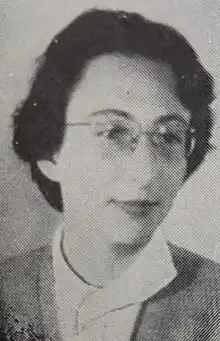Zenia Larsson | |
|---|---|
 | |
| Born | 2 April 1922 Łódź, Poland |
| Died | 4 September 2007 (aged 85) Stockholm, Sweden |
| Occupation | Writer, sculptor |
| Language | Swedish |
Zenia Szajna Larsson, née Marcinkowska (1922–2007) was a Polish-Swedish[1] writer and sculptor of Jewish descent. Larsson was a Holocaust survivor who was among the first in Sweden to describe their war experience.
Early life
She was born on 2 April, 1922 in Łódź,[2] as Zenia Marcinkowska.[3] She grew up in a working-class neighbourhood[2] and became friends with Chava Rosenfarb, with whom she later exchanged letters for many years.[4] In the years 1940–1944 she was confined in the Łódź Ghetto.[2] During this time, Zenia's father committed suicide so that his wife and daughter could get his food rations; it was Rosenfarb who discovered the body.[4] After the liquidation of the ghetto, Zenia was deported to the Auschwitz concentration camp, and then moved to Bergen-Belsen, where she was liberated in April 1945.[2] With the help of the Red Cross, she emigrated to Sweden in August of the same year.[5]
Career
In Sweden, she first started studying at Konstfack, then moved on to the Royal Institute of Art,[5] where she studied sculpture with Eric Grate.[2] Working with such materials as wood, terracotta, plaster and marble, Larsson chiefly worked on character studies and portraits, including a portrait of Astrid Lindgren.[2] Her works in public spaces include the Vandraren sculpture in Falun.[2]
In 1960, Larsson made her debut as a writer with the autobiographical novel Skuggorna vid träbron,[2] in which she described the experience of World War II from the point of view of her alter ego, a girl named Paula Levin.[2][5] It was a first instalment in a war trilogy, which also includes Lang är gryningen (1961) and Livet till mötes (1962).[2][3] Thus, Larsson became one of the first Holocaust survivors in Sweden to describe their war experiences.[2][4]
Larsson's literary output includes a number of novels, short stories, essays and radio plays.[2] She also published her letters to Chava Rosenfarb in a collection entitled Brev Fran En Ny Verk Lighet (1972).[5]
References
- ↑ "Zenia Larsson". Nationalencyklopedin. Retrieved 2023-01-07.
- 1 2 3 4 5 6 7 8 9 10 11 12 13 Larsson, Lisbeth (2018-03-08). "Zenia Szajna Larsson". Svenskt kvinnobiografiskt lexikon. Retrieved 2023-01-07.
- 1 2 3 Kwiatkowski, Aleksander. "Zenia Larsson. Znana i nieznana" (in Polish). Retrieved 2023-01-07.
- 1 2 3 Morgentaler, Goldie (2018-01-26). "A Tale of Two Writers: Chava Rosenfarb and Zenia Larsson". Tablet Magazine. Retrieved 2023-01-07.
- 1 2 3 4 "Larsson, Zenia Szajna". Nordic Women's Literature. Retrieved 2023-01-07.